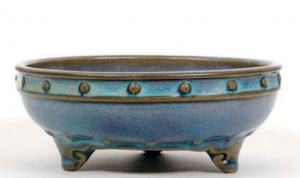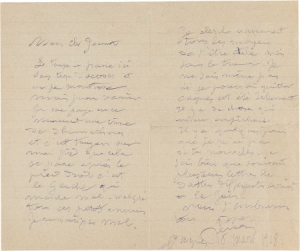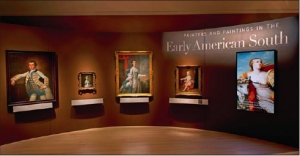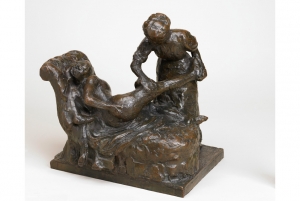|
Displaying items by tag: objects

The Croydon Council, a local authority in south London, will sell 24 antique Chinese ceramic vases, bowls and bottles to benefit the redevelopment of Fairfield Halls, a 50-year-old arts center in the area. Local businessman Raymond Riesco gifted the valuable objects to the Council in 1959 as part of a 230-piece collection of artifacts that included Ming dynasty bowls. The 206 objects retained by the Council will remain on view for the public.
The decision to break up the collection has drawn criticism from the museum sector. David Anderson, president of the Museum Association, told the BBC, “Croydon’s decision to sell valuable Chinese ceramics threatens not just its own reputation, but that of the museum sector as a whole. It would undermine the widespread public trust in museums and I strongly urge them to reconsider.”
Arts Council England has also voiced opposition to the sale and penned a letter to the Croydon Council earlier this month warning them that their decision was not in line with English museum standards.

Sometime after 1994, a former employee of Sweden’s National Library stole approximately 56 rare antique books once belonging to the country’s royal family. The thief, Anders Burius, eventually confessed to the theft, consigned the objects to the German auction house, Ketterer Kunst, and subsequently committed suicide.
In 1998, investigators were able to track 13 of the stolen volumes from Ketterer Kunst to the U.S. where Stephan Loewentheil, a Baltimore-based book dealer, bought two of the volumes, unaware that they were stolen. On Wednesday, July 24, 2013, the FBI were finally able to return the objects to the Swedish government, whereby officials honored Loewentheil for his assistance in recovering the books.
The recovered books include a 19th century German volume about the Mississippi River by Henry Lewis and a 17th century French book about the Louisiana territory by Louis Hennepin. The latter features the first published description of Niagara Falls and the first published landscape of the Louisiana Territory.
While Sweden and the National Library are thrilled to have the volumes back, a large portion of the works stolen by Burius are still missing.

The Phillips Collection in Washington, D.C. is currently hosting the exhibition Georges Braque and the Cubist Still Life, 1928-1945, the first in-depth look at the Cubist master’s works preceding World War II. During this period, Braque used the theme of still life to hone his pioneering Cubist style. The exhibition presents 44 works from this period as well as related objects that help trace the artist’s evolution from a painter of still lifes to interiors in the late 1920s, to large-scales spaces in the 1930s, to personal interpretations of everyday life in the 1940s.
The exhibition brings together Braque’s Rosenberg Quartet (1928-1929) for the first time in 80 years. The four canvases were used as models for marble panels in the Paris apartment of Braque’s art dealer, Paul Rosenberg. All in varying degrees of completion, the works come together to reveal the different stages of Braque’s artistic process.
Duncan Phillips, founder of the Phillips Collection, was a well-known champion of Braque’s work and helped introduce his paintings to a wider American audience through acquisitions and exhibitions. Georges Braque and the Cubist Still Life, 1928-1945 will be on view at the Phillips Collection through September 1, 2013.
Sicily: Art and Invention between Greece and Rome will not go on view at the Cleveland Museum of Art as previously expected. Sicilian officials claim that the loan has been hurting the island’s economy and have called off the traveling exhibition, which was slated to open at the institution in September.
The show features 145 objects that celebrate the Greek culture that dominated Sicily between the 5th and 3rd centuries, B.C.E. Highlights include a statue of a charioteer that measures six feet tall and a gold libation bowl, both of which are popular tourist attractions. The works are typically displayed at the Whitaker Villa on the tiny island of Mozia off of Sicily’s main landmass.
Sicily: Art and Invention between Greece and Rome is currently on view at the J. Paul Getty Museum in Los Angeles through August 19, 2013. The Getty has offered to cover the Cleveland Museum of Art’s costs, which were to be shared between the institutions.

The Dallas-based auction company, Heritage, will host a number of sales featuring objects from Pierre-Auguste Renoir’s (1841-1919) personal archive starting on September 19, 2013 in New York. Items include the artist’s eyeglasses, funeral receipts, clothing, paperwork, photos, medals, statues and books signed by fellow artists. The sale will also include letters and writings by Renoir that detail his travels, inspirations for paintings and relationships with models and dealers.
During the 1970s, Renoir’s heirs moved from France to Canada and then to Texas, taking the artist’s belongings with them. The trove, which will be broken into 150 lots, has been stored in various spots across North America until now. Scholars are hoping that an institutional buyer will step up and make a bulk purchase as the collection holds significant historic value.
The collection was put up for auction once before in 2005 but it failed to sell. Following the sale, anonymous buyers from Arizona purchased the lot. They are now consigning the works to Heritage.

Larry Ellison, co-founder and CEO of the enterprise software company, Oracle, has loaned a portion of his inimitable collection of Japanese art to the Asian Art Museum in San Francisco for the exhibition In the Moment: Japanese Art from the Larry Ellison Collection. The show presents 64 objects that span over 1,000 years.
Highlights from the show include significant works by well-known artists of the Momoyama (1573-1615) and Edo (1615-1868) periods as well as important examples of religious art, lacquer, woodwork and metalwork. Ellison assembled a large portion of his collection with the help of the Asian Art Museum’s former director, Emily Sano. Serving as Ellison’s personal art curator and advisor, Sano helped the billionaire acquire hundreds of important Japanese art objects including 17th century folding screens by Kano Sansetsu and 18th century paintings by Maruyama Okyo.
In the Moment: Japanese Art from the Larry Ellison Collection will be on view at the Asian Art Museum through September 22, 2013.

The two leading decorative arts institutions in the South are embarking on a new level of collaboration between their organizations. The Art Museums of Colonial Williamsburg (the Abby Aldrich Rockefeller Folk Art Museum and the DeWitt Wallace Decorative Arts Museum) and the Museum of Early Southern Decorative Arts (MESDA) at Old Salem Museums & Gardens have entered a five-year agreement for reciprocal extended loans. The museums have already collaborated on the recently opened exhibition, Painters and Paintings in the Early American South (on view through September 7, 2014) at the Arts Museums of Colonial Williamsburg. With nine major paintings MESDA is the largest single lender to the exhibition, while select objects from the Art Museums of Colonial Williamsburg are already on display at MESDA.
Many of MESDA’s forty objects on loan to Colonial Williamsburg will be featured in a new, long-term exhibition opening at Colonial Williamsburg’s DeWitt Wallace Decorative Arts Museum in January 2014. A Rich and Varied Culture: The Material World of the Early South will feature materials made in or imported to the South before 1840. The two museums have already begun discussions on several ways in which they can broaden the collaboration. Ideas include research exchanges, conservation, joint exhibitions and, potentially, joint publications. Further evidence of the collaboration will be seen in Colonial Williamsburg’s 66th annual Antiques Forum, February 14–18, 2014. Tentatively titled “New Findings in the Arts of the Coastal South,” the program will feature multiple speakers from both institutions as well as a number of experts from museums and universities across the nation.
IN ADDITION
This May MESDA honored Richard Hampton Jenrette with the first ever Frank L. Horton Lifetime Achievement Award for Southern Decorative Arts. A native of Raleigh, North Carolina, during the past forty years Jenrette has owned and restored a dozen historic properties. He has retained six of them and furnished each with period antiques, many original to the houses. Threads of Feeling, on view at the DeWitt Wallace Decorative Arts Museum, Colonial Williamsburg, through May 2014, displays the Foundling Hospital of London’s eighteenth century record books that retain textile tokens used to identify babies left in its care. The exhibit and catalogue provide insight into social and textile history and is the only American venue. October 20–22, 2013, Williamsburg will host a symposium to explore the objects in context. For information on the institutions, exhibitions, and symposium, visit colonialwilliamsburg.com and mesda.org.

Edgar Degas’ (1834-1917) La Masseuse (The Masseuse), which was once owned by the German-born British painter Lucien Freud (1922-2011), has been given to the Walker Art Gallery as part of the British government’s Acceptance in Lieu (AiL) of law. The AiL is a provision under which inheritance tax debts can be written off in exchange for the acquisition of objects of national importance.
The Degas sculpture was one of three works by Degas bequeathed to England following Freud’s death. The Walker Art Gallery, which is located in Liverpool and houses one of the largest art collections in England outside of London, was granted the sculpture after a competitive process with other UK museums and galleries. La Masseuse, Degas’ only two-figure sculpture, will join the artist’s painting Woman Ironing at the Walker.
Xanthe Brooke, Curator of European Art at the Walker Art Gallery, said, ‘We’re very grateful to Arts Council England for allocating the sculpture to the Walker Art Gallery, where it will be appreciated by an enthusiastic and diverse audience.”
The Portland Museum of Art in Maine presents Shangaa: Art of Tanzania. The first major exhibition in the United States to focus on the traditional arts of Tanzania, Shangaa includes 165 objects on loan from private and public collections throughout the U.S. and Europe. While most of the works are sculptural in nature, styles range from expressionistic to abstract to refined.
“Shangaa” means “to amaze” in Swahili and that is the intent of the exhibition. Curated by Tanzanian art specialist Dr. Gary van Wyk, Shangaa includes works ranging in date from the 19th century through today. The exhibition illustrates how Tanzanian culture uses art to channel energy, mark the passage into adulthood, and celebrate life among many other things.
Shangaa: Art of Tanzania will be on view through August 25, 2013.

A California couple has gifted the Minneapolis Institute of Arts a collection of Japanese Art worth $25 million. The gift is one of the largest in the museum’s history and includes around 1,700 objects such as paintings, sculptures, ceramics, woodblock prints, and bamboo baskets and spans more than 1,000 years. Together with a pending bequest of 500 Japanese objects from a New York-based collector, the Minneapolis Institute of Arts will become one of the most comprehensive venues for viewing Japanese Art.
The donors, Libby and Bill Clark, have been acquainted with the museum’s director, Kaywin Feldman, since the mid-1990s when she ran an art museum in Fresno, CA. The Clarks had set up a small museum and study center devoted to Japanese art at their home in central California. Bill Clark’s love of Japanese culture was sparked during tours of Japan while serving in the U.S. Navy. He began collecting seriously in the 1970s and launched the nonprofit Clark Center for Japanese Art and Culture in 1995. The Clarks often loaned works from their collection to art museums and helped organize traveling exhibitions. In addition to the Clarks’ gift, the MIA is purchasing other works from their collection using $5 million from a special endowment for art purchases.
The Minneapolis Institute of Arts has been devoted to showcasing Japanese Art since it opened in 1915. Currently, 15 galleries are devoted to its collection of 50,000 Japanese art objects. The exhibition, The Audacious Eye, will present a portion of the Clarks’ gift and will be on view from October 6, 2013 to January 12, 2014.
|
|
|
|
|